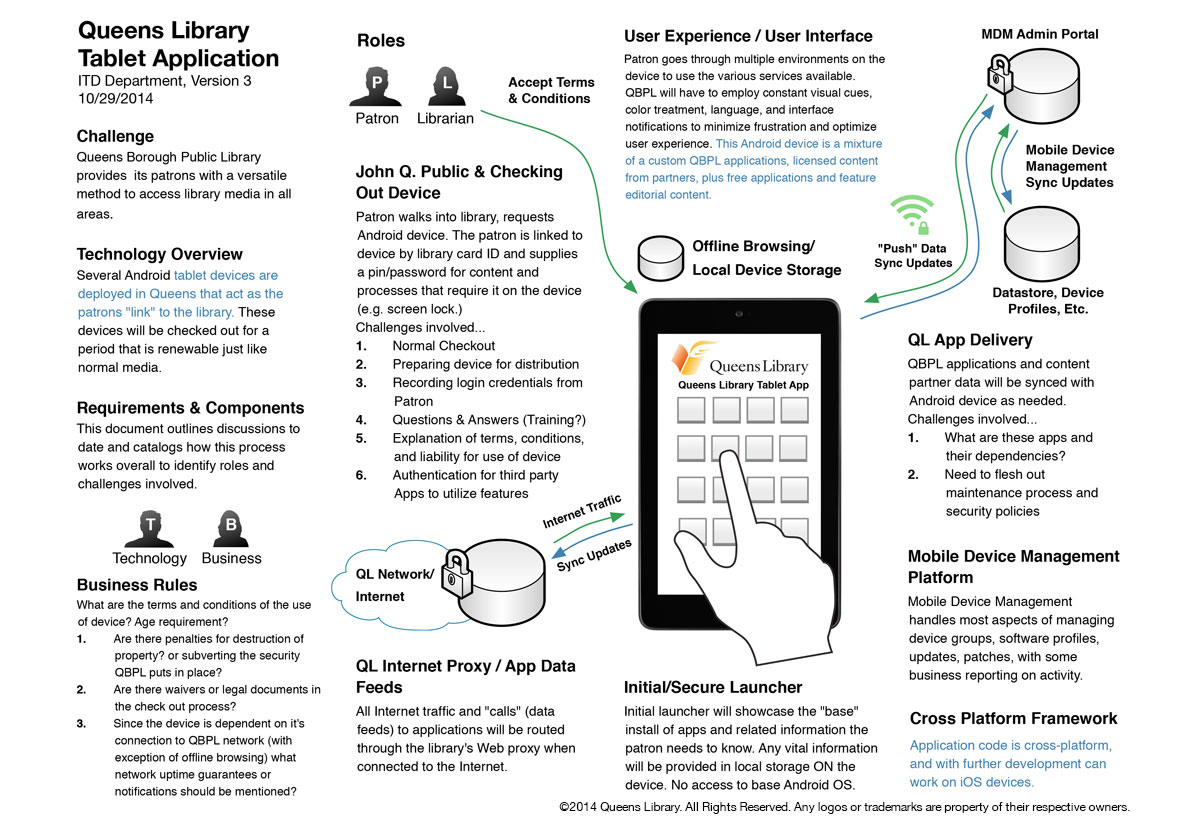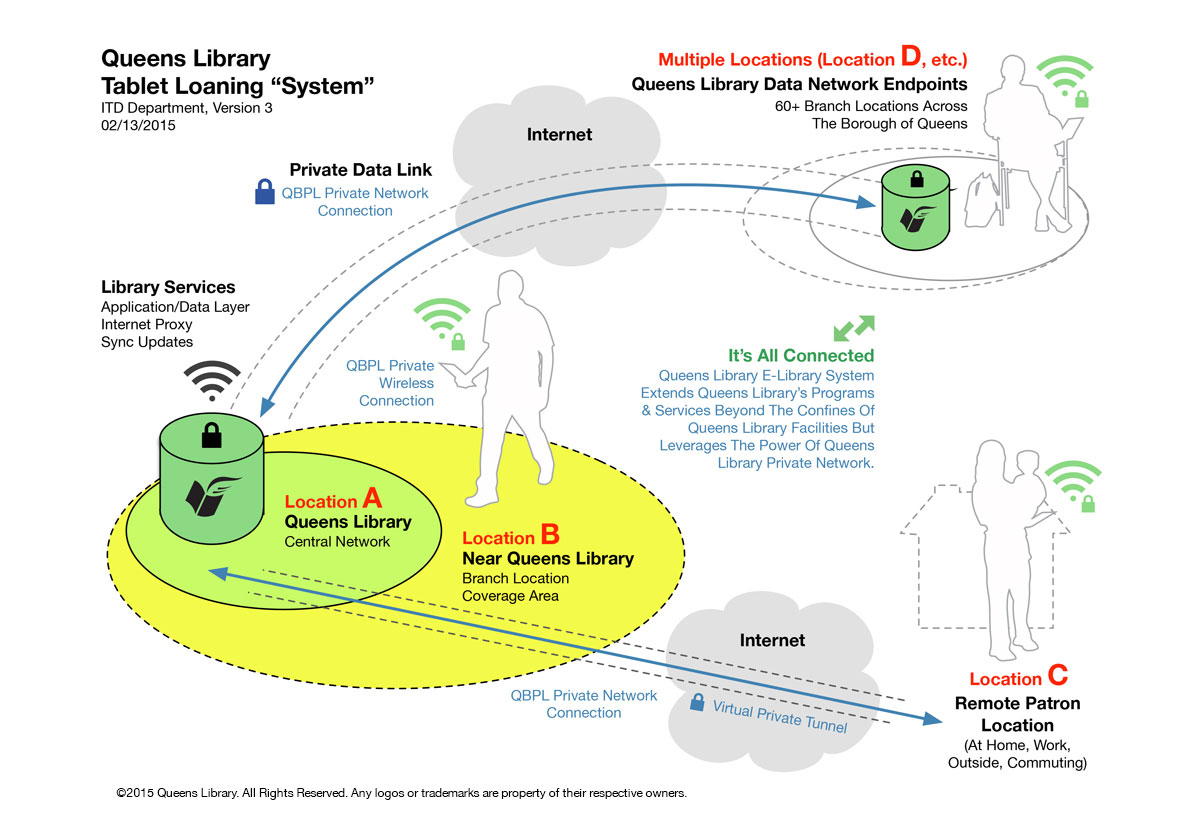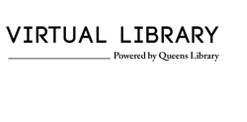Anatomy of the Virtual Library: Discovery and Delivery Components
Libraries can give patrons access to a single comprehensive catalog that bridges their digital and physical catalog. Physical media, ebooks, unique collections, programs, and more can be viewed in one experience. Currently, content providers often only allow searches within the products they have rights to license, depriving users of the comprehensive library experience. Discover below how the Queens Virtual Library brings together technology, automation, and human workflows to make this happen.
Queens Virtual Library Diagrams
Below you will find instructive diagrams that illustrate, how components fit together and some of the conversations that took place internally in Queens Library to bring the vision.

Exhibit 1 - Technology Topography
This diagram details conceptually how the Virtual Library platform seeks to create a singular technology landscape to modernize library operations. This includes updating how we interact with our vendor partners and technology systems, as well as the general public.

Exhibit 2 - Early Tablet Interface Concept
An early conceptual drawing detailing the early conversations that took place within Queens Library about tablet devices, user experience, what the different roles within the organization had to be concerned with, and other nuances of the tablet loaning program.

Exhibit 3 - Tablet Loaning System
General overview of how Queens Library seeks to extend out it’s services into the community. Using computer workstations or internet-enabled mobile devices inside, or outside, even at remote locations — patrons should still be able to access a reasonable level of services or programming.
Content Sources
Single Login for Access
Integrated Media Search and Discovery Across Digital/Physical Catalogs
eResources of Queens Interest
Articles and Databases
Public Domain Material
International eResources in multiple languages
Plug and Play Content Sources (via API)
Single Login for Access
Queens Virtual Library strives for a single sign-on to enable our patrons to obtain access to all library-supplied resources. While we are on our way there, we are working in phases with partners and developers to remove unnecessary logins and access obstacles. In our current user experience for our platform, we have leveraged our partners APIs to give our users as seamless a user path as possible to access their media while safeguarding digital rights management and patron security. This has resulted in a massive reduction in unnecessary clicks and a streamlined user experience that has met with rave reviews. In addition, we have concentrated heavily on laying the foundation for an easy to understand, easy-to-use user interface, with a nod to multi-lingual applications and language translation in the future.
Integrated Media Search and Discovery Across Digital/Physical Catalogs
As previously stated, Queens Virtual Library does not replace public libraries or physical spaces. What it does is enhance the discovery options and exposure to the public library's (or any library's) resources in one unified interface. Queens Virtual Library also tears down information silos and obstacles to access by giving better context and meaning to search results and browsing options, with the ideal being true immersive discovery across media types, research tools, and physical and digital channels, for a true exercise in information literacy.
eResources of Queens Interest
Queens Virtual Library is woven into our approach towards service delivery for the Queens Library Archives and special projects like the Queens Memory Project that are primarily patron-driven. These Queens Library services capture oral histories, photographs, maps, art collections, newspapers, and more, in an effort to preserve Queens history. Our technology provides a rich intake and cataloging tool that will be leveraged publicly and privately (within our archive facility) and will innovate in the area of public/private coordination. In addition, we are working with grantors and technology partners to expand our self-publishing capability to add new and original digital content to our Virtual Library platform.
Articles and Databases
Queens Library is working and actively seeking partners in the research database area that will allow immersive search and deep linking into their resources to integrate rich content into our standard OPAC search, thereby fully exposing all licensed, library-supplied options to our patrons by efficient search procedures, without the need for multiple logins or reinitiating keyword or filtered searches. Currently, users can browse our eResources on a service-provider level, but we hope to push the platform and the user experience to the next level soon.
Public Domain Material
Queens Library is working towards establishing its own digital e-reader technology to complement its current robust e-reader partner options. Our Virtual Library platform team is working on multiple fronts to bring this to a reality in open source projects and with willing vendor partners to make public domain titles accessible across our digital channels, such as our website, tablet lending program, and mobile app. We are currently working out the details of how to highlight, manage, and distribute these titles in our Virtual Library experience.
Currently, Queens Library offers a rich variety of ESOL, new immigrant, and language programming and services. On the digital front, we offer streaming language education services, and a wide array of foreign language titles in print and eBook formats, as well as audiobooks and indy movies. Queens Library is researching and roadmapping native language searches in our search-and-discovery layer, as well as seeking to ease access to these titles for non-English speakers in the interfaces of all our channels, whether physical or digital.
Plug and Play Content Sources (via API)
Extending the Readers First conversations, Queens Library has actively engaged our ILS partner and eContent partners since 2013 to push the capabilities of their Web Services (APIs), where appropriate, and to work with us on eliminating needless logins and other breakdowns in seamless interaction with content and information. In addition, Queens Library is leading conversations about speeding ingestion of licensed media into online catalogs, and allowing centralized patron account management inside a library-controlled user experience, eliminating external user portals and cutting down user confusion and frustration.
